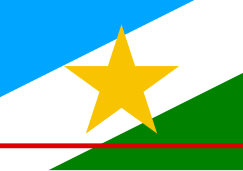 | |
| Use | Civil and state flag |
|---|---|
| Proportion | 2:3 |
| Adopted | 14 June 1996 |
The flag of Roraima is one of the official symbols of the state of Roraima in Brazil. [1]
 | |
| Use | Civil and state flag |
|---|---|
| Proportion | 2:3 |
| Adopted | 14 June 1996 |
The flag of Roraima is one of the official symbols of the state of Roraima in Brazil. [1]
The flag was designed by Mário Barreto, and instituted by state law No. 133 of June 14, 1996, which "Orders the adoption of Symbols of the State of Roraima, in accordance with Article 10 of the State Constitution and other measures". [2] [3]
Its format consists of a rectangle with a proportion (width-length) of 14 x 20 modules or equal parts, and its design is divided into three diagonal bands from left to right, and from bottom to top. The colors of the bands are, respectively: turquoise blue, white and flag green. Near the bottom of the flag is a narrow red band. In the center of the flag, resting on the red band, there is a gold star with dimensions that go beyond that of the central white band, referring to Wezen, from the constellation Canis Major. [2] [4]
The main colors of the flag (green, yellow, blue and white) are a representation of the integration of the state with Brazil, separately each color has a specific meaning: [5] [6]
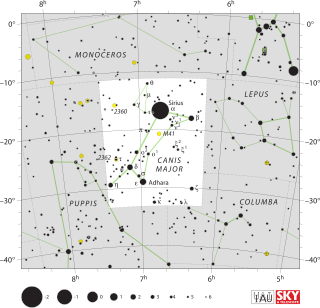
Canis Major is a constellation in the southern celestial hemisphere. In the second century, it was included in Ptolemy's 48 constellations, and is counted among the 88 modern constellations. Its name is Latin for "greater dog" in contrast to Canis Minor, the "lesser dog"; both figures are commonly represented as following the constellation of Orion the hunter through the sky. The Milky Way passes through Canis Major and several open clusters lie within its borders, most notably M41.

The national flag of Brazil, is a blue disc depicting a starry sky spanned by a curved band inscribed with the national motto "Ordem e Progresso", within a yellow rhombus, on a green field. It was officially adopted on 19 November 1889 — four days after the Proclamation of the Republic, to replace the flag of the Empire of Brazil. The concept was the work of Raimundo Teixeira Mendes, with the collaboration of Miguel Lemos, Manuel Pereira Reis and Décio Villares.
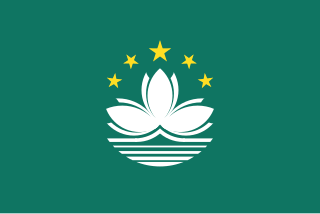
The flag of Macau, officially the regional flag of the Macau Special Administrative Region of the People's Republic of China, is light green with a lotus flower above the stylised Governador Nobre de Carvalho Bridge and water in white, beneath a circular arc of five golden five-pointed stars: one large star in the center of the arc with two smaller stars on each side of the large star, each with a point angled directly outward from the center of the common circle on which they lie.

The flag of Bolivia is the national flag of the Plurinational State of Bolivia. It was originally adopted in 1851. The state and war flag is a horizontal tricolor of red, yellow and green with the Bolivian coat of arms in the center. According to one source, the red stands for Bolivia's brave soldiers, while the green symbolizes fertility and yellow the nation's mineral deposits.

The national flag of Cape Verde was adopted on 22 September 1992, replacing the flag adopted during Cape Verdean independence, fought for with Guinea-Bissau, another former Portuguese colony on mainland West Africa.

The national emblem of Cape Verde contains a circle within which is written the name of the nation in Portuguese. Within the circle are a torch and triangle, symbols of freedom and national unity. At the top of the shield is a plumbob, a symbol of righteousness; three chain links are at the bottom. This emblem replaces the earlier variant with the seashell that had been in use since independence. The current emblem was adopted in 1992.

The Flag of Portugal is the national flag of the Portuguese Republic. It is a rectangular bicolour with a field divided into green on the hoist, and red on the fly. The lesser version of the national coat of arms of Portugal is centered over the colour boundary at equal distance from the upper and lower edges. Its presentation was done on 1 December 1910, after the downfall of the constitutional monarchy on 5 October 1910. However, it was only on 30 June 1911, that the official decree approving this flag as the official flag was published. This new national flag for the First Portuguese Republic, was selected by a special commission whose members included Columbano Bordalo Pinheiro, João Chagas and Abel Botelho.

The coat of arms of Brazil was created on 19 November 1889, four days after Brazil became a republic. It consists of the central emblem surrounded by coffee and tobacco branches, which were important crops in Brazil at that time. In the round shield in the center, the Southern Cross can be seen. The ring of 27 stars around it represents Brazil's 26 states and the Federal District.

Delta Canis Majoris, officially named Wezen, is a star in the constellation of Canis Major. It is a yellow-white F-type supergiant with an apparent magnitude of +1.83. Since 1943, the spectrum of this star has served as one of the stable anchor points by which other stars are classified.

The national emblem of East Timor is one of the national symbols of East Timor.

The flag of the Federal District is the official flag of the Federal District. The flag was created by the poet Guilherme de Almeida, and officialized on August 25, 1969. The Cross of Brasília in the center symbolizes the indigenous heritage and the strength that hails in all directions.

The flag of Acre is one of the official symbols of the state of Acre, Brazil. The current flag was introduced by Law No. 1170 of 22 December 1995, adopting the design of the flag of the Republic of Acre, as modified by Resolution No. 5 of 24 January 1921. The faixa governamental used by the Chief Executive of Acre is made up of the colors of the flag, and also boasts the red star.
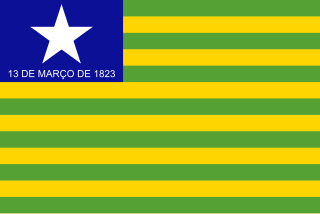
The flag of Piauí is one of the official symbols to the state of Piauí, in Brazil.

The flag of the state of São Paulo, Brazil, serves as one of the state's symbols, along with the state's coat of arms and anthem. It was designed by the philologist and writer Júlio Ribeiro in 1888, with his brother-in-law, Amador Amaral, a graphic artist. The flag has thirteen black and white stripes and a red rectangle in the upper left corner holding a white circle enclosing an outline map of Brazil in blue. There is a yellow star in each corner of the red rectangle.

The flag of Pernambuco is one of the official symbols of the Brazilian state of Pernambuco. It is a bicolor pennant, blue and white, with the colors broken horizontally into two unequal sections, with blue in the upper and larger rectangle, the rainbow composed of three colors, red, yellow and green, with a star in above and below the sun, inside the semicircle, both in yellow, and, in the lower and smaller white rectangle, a red cross.

The flag of Mato Grosso is the official flag of the Brazilian state of Mato Grosso. The current flag was introduced on 31 January 1890 by the 2nd Decree of the state of Mato Grosso. It was introduced only 2 months after the Empire of Brazil was overthrown and the First Brazilian Republic was created, making this one of the first Brazilian state flags. As such, it uses the same colors and symbolism used in the Brazilian flag to signify the republican ideals of the founders of the newly formed nation.

The flag of Espírito Santo is the official flag of the Brazilian state of Espírito Santo. The current flag was designed in 1908 and officially adopted on 24 April 1947 through Decree 16.618 of the state of Espírito Santo.
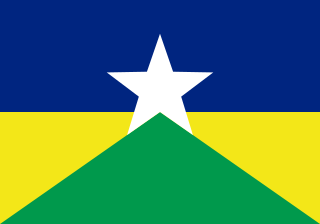
The flag of Rondônia is the official flag of the Brazilian state of Rondônia. The current flag was introduced by the 7th Decree of the state of Rondônia on 31 December 1981, a mere 9 days after Rondônia was elevated from a federal territory to state.
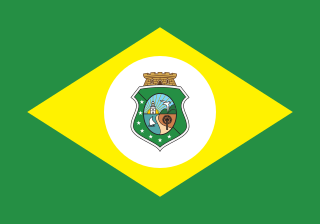
The flag of Ceará is the official flag of the Brazilian state of Ceará. The original version of the flag was adopted on 25 August 1922 by state decree 1,971 of Ceará.